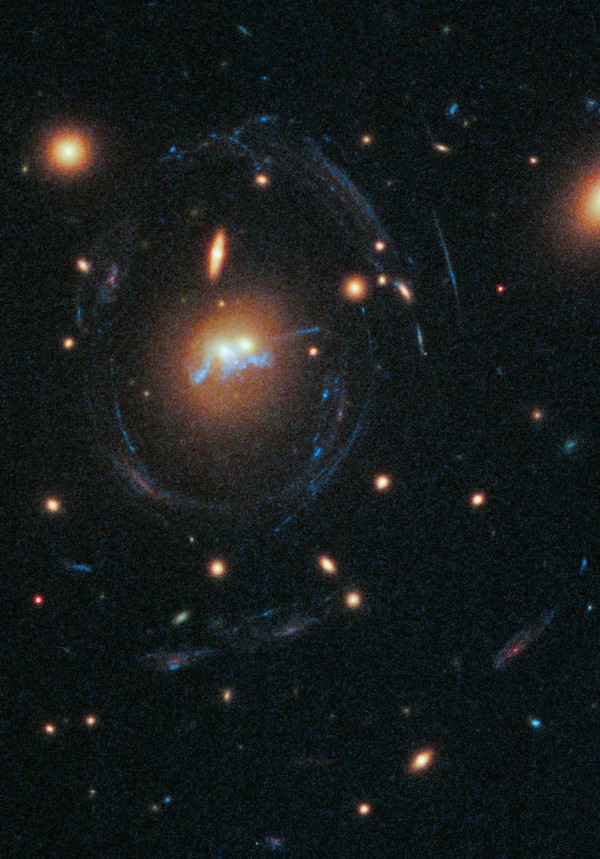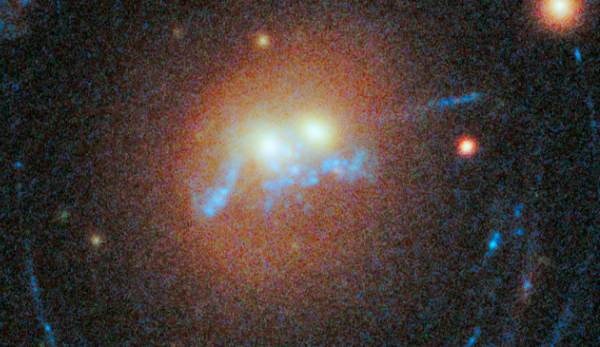“Look and think before opening the shutter. The heart and mind are the true lens of the camera.” -Yousuf Karsh
When you find an incredibly huge, dense collection of mass, all together in one place, it generally indicates a galaxy cluster of tremendous size.
 Image credit: NASA, ESA, G. Tremblay (ESO), M. Gladders and M. Florian (University of Chicago), S. Baum, C. O’Dea, K. Cooke (RIT), M. Bayliss (Harvard-Smithsonian Center for Astrophysics), H. Dahle (University of Oslo), T. Davis (ESO), J. Rigby (NASA/GSFC), K. Sharon (University of Michigan), E. Soto (Catholic University of America), and E. Wuyts (Max Planck Institute for Extraterrestrial Physics); Acknowledgment: NASA, ESA, and the Hubble Heritage (STScI/AURA)-ESA/Hubble Collaboration.
Image credit: NASA, ESA, G. Tremblay (ESO), M. Gladders and M. Florian (University of Chicago), S. Baum, C. O’Dea, K. Cooke (RIT), M. Bayliss (Harvard-Smithsonian Center for Astrophysics), H. Dahle (University of Oslo), T. Davis (ESO), J. Rigby (NASA/GSFC), K. Sharon (University of Michigan), E. Soto (Catholic University of America), and E. Wuyts (Max Planck Institute for Extraterrestrial Physics); Acknowledgment: NASA, ESA, and the Hubble Heritage (STScI/AURA)-ESA/Hubble Collaboration.
Under circumstances like this, the phenomenon of gravitational lensing is often ubiquitous, with serendipitously placed background galaxies getting stretched into arcs, rings, and multiple images across the sky. But in rare, spectacular cases, we can catch two giant elliptical galaxies in the act of merging, leading to phenomena -- like the formation of strings of super star clusters -- never before seen on scales this large.
 Image credit: NASA, ESA, G. Tremblay (ESO), M. Gladders and M. Florian (University of Chicago), S. Baum, C. O’Dea, K. Cooke (RIT), M. Bayliss (Harvard-Smithsonian Center for Astrophysics), H. Dahle (University of Oslo), T. Davis (ESO), J. Rigby (NASA/GSFC), K. Sharon (University of Michigan), E. Soto (Catholic University of America), and E. Wuyts (Max Planck Institute for Extraterrestrial Physics); Acknowledgment: NASA, ESA, and the Hubble Heritage (STScI/AURA)-ESA/Hubble Collaboration.
Image credit: NASA, ESA, G. Tremblay (ESO), M. Gladders and M. Florian (University of Chicago), S. Baum, C. O’Dea, K. Cooke (RIT), M. Bayliss (Harvard-Smithsonian Center for Astrophysics), H. Dahle (University of Oslo), T. Davis (ESO), J. Rigby (NASA/GSFC), K. Sharon (University of Michigan), E. Soto (Catholic University of America), and E. Wuyts (Max Planck Institute for Extraterrestrial Physics); Acknowledgment: NASA, ESA, and the Hubble Heritage (STScI/AURA)-ESA/Hubble Collaboration.
Go get the whole story in images and words on Mostly Mute Monday!

Weren't ellipticals supposed to have lost their gas? Where is the gas to fuel star formation coming from?
Stars give off gas when they explode.
Don't we all.
The world will end not with a bang but a pfffffff...?
(Also, Omega, the claim that there is no gas in the ellipticals is wrong, you'd be as wrong to claim women don't wear trousers because they are known to buy dresses)
I honestly don't think that galaxies would ever come so close together that something like this would happen...It might be just me but the idea doesn't sit well with me. If it were truly so then scientists would make a bigger deal out of it.
u15085504
There's absolutely no reason why galaxies wouldn't do this.
The bullet galaxy indicates where this has happened in the recent past. Bhode's galaxy indicates one about to happen. And there's a lot of knowledge in astronomy that we're going to do it with Andromeda.
It's not made a big deal of because it's a billion years away, and that's rather too long for humans who live decades.
Prof,
The tidal dissipation of loosely held self gravitating collections of mass, like globular clusters or galaxies is quite strong. It means that relatively close gravitational encounters between such objects usually result in capture and merger activity.
Questions? Could DARK MATTER no matter how weakly dispersed, be associated with MANIFESTED BIOLOGICAL MATTER here on Earth? Including the human brain?
Could DARK MATTER be the ELECTROMAGNETIC FORCE (PHOTON-LESS) + STRONG FORCE (QUARK-LESS)Perhaps these FORCES did not differentiate after the Bib Bang or recombined sometime later?
Re Above: No.